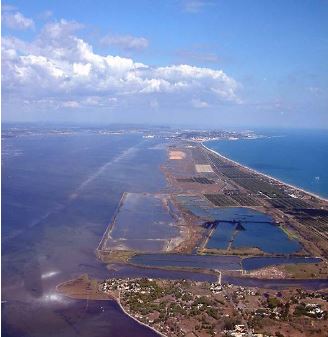2 SUSTAINABLE MANAGEMENT IN MEDITERRANEAN COASTAL LAGOONS: INTERACTIONS AMONG CAPTURE FISHERIES, AQUACULTURE AND THE ENVIRONMENT
Stefano Cataudella, Donatella Crosetti, Eleonora Ciccotti, Fabio Massa
Wetlands and coastal lagoons are valuable and sensitive environments and their important role has been widely recognized at the international level, in particular within the framework of the Convention on Wetlands (Ramsar, Iran, 1971) – the so-called “Ramsar Convention” – and the Convention on Biological Diversity (CBD) signed at the United Nations Conference on Environment and Development (UNCED) (Rio de Janeiro, Brazil, 1992).
Lagoons are an integral part of the coastal landscape. They are the typical zones between the continent and the sea where the existence of ecological gradients, due to the transition from the continental to the marine domain creates the peculiar ecological conditions that characterize these ecosystems. Due to the sedimentological, hydrological and biological gradients, coastal lagoons form complex mosaics of different habitats where one can observe a significant environmental heterogeneity, not only from one lagoon to another but also within the same lagoon (e.g. connectivity of food webs, interfaces with the lagoon’s watershed and the adjacent sea, etc.). The composite structure and functions of these highly resilient and productive ecosystems, together with their efficient trophic transfer, offer unique opportunitiesto to create enabling environments on which human activities can be based.
In particular, the rich fish assemblages found in lagoons have always represented a source of income and livelihood for human settlements throughout the Mediterranean basin.
Since ancient times, coastal lagoons have offered important spatial potentialities for coastal communities to develop fishing exploitation patterns and traditional lagoon management models, which have been applied in both time and space in the Mediterranean and in other parts of the world. Lagoons are therefore historically important since they form an integral part of the cultural heritage of coastal communities throughout the GFCM area.

Aerial view of the Thau lagoon (France), photo ©H. Farrugio, 2011
Recently, coastal lagoons have raised considerable environmental concerns: land claiming, pollution and the lack of management, among other factors, have strongly modified both the structure and the functioning of these sensitive coastal ecosystems. The lack of an adequate management of these areas has been recognized as the main cause leading to an ecological degradation of the lagoons and of their sensitive habitats. This is also seriously affecting traditional aquaculture and capture fisheries activities, which have been historically contributing to the conservation of lagoons environment and to the well-being of coastal communities and are at risk of disappearing.
This chapter presents a review of relevant and up-to-date information on Mediterranean coastal lagoons, gathered in country reports (see paragraph 1.3 and Part 3) and exiting literature. 7
Selected examples have been extracted from the country reports and are illustrated within each section. Particular reference is made to the northern Adriatic valli complex5 (Italy), which represents an interesting historical reference model where sound management strategies have enabled to ensure over time the sustainability of fishing and hunting in these coastal areas (Ardizzone et al., 1988). The vocation of the valli for fisheries clearly comes out in their ancient Latin name of “piscatoriae aquae” (waters for fisheries) (Del Rosso, 1905).